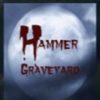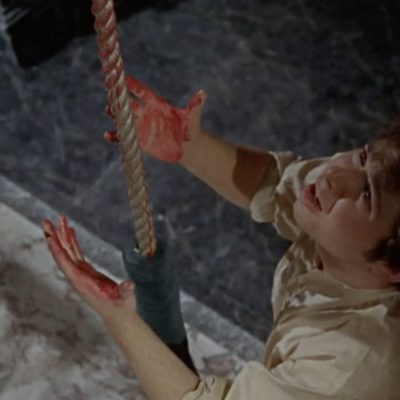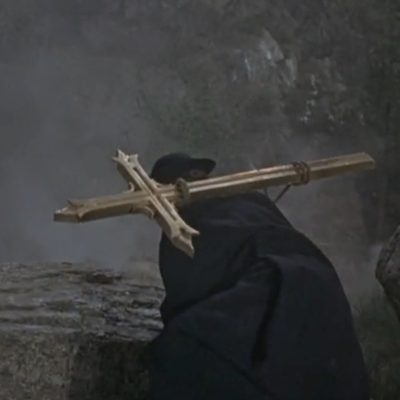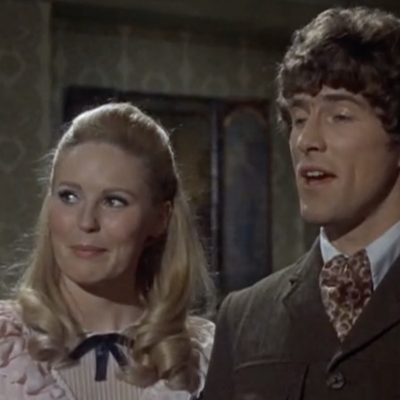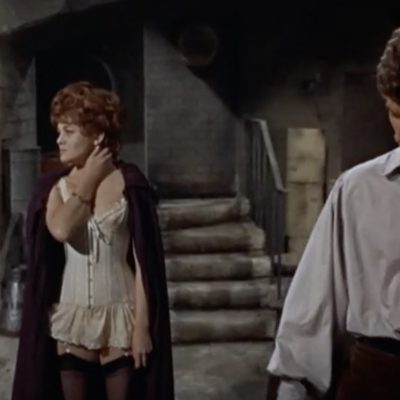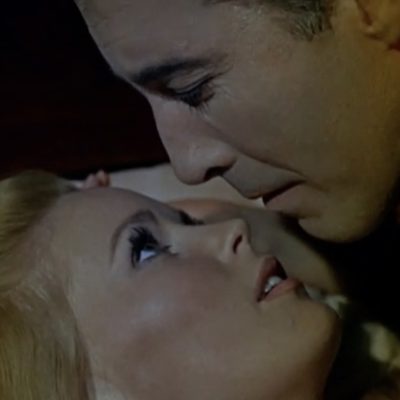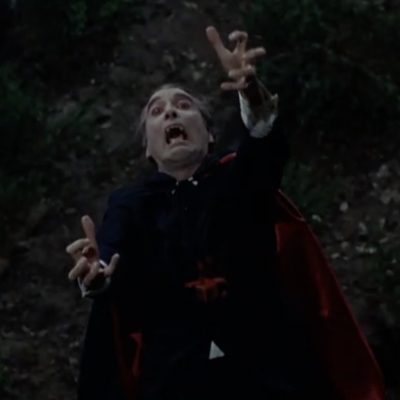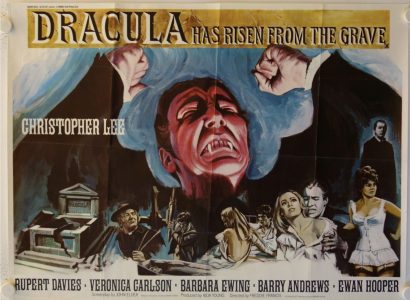When the Monsignor visits the tiny village near Castle Dracula, he finds that, although it is a year since the Count was destroyed, the villagers are still living in fear and that the local priest has said mass to an empty church. Outraged by their attitude – “There is no evil in the house of God!” – the Monsignor insists that the priest accompany him to the castle, where he will perform the service of exorcism. They set out up the mountain, but eventually, overcome by fear, the priest will go no further and the Monsignor ontinues alone. As he reads the service and seals the castle door with a huge crucifix, a terrible thunderstorm erupts, causing the priest on the mountain to stumble and fall. He cracks both his head and the ice of a mountain stream and his blood trickles down on to the lips of Dracula, whose body lies entombed in the ice. As more blood flows into his mouth, Dracula’s lips begin to quiver….

Production Details
A Hammer film production presented by Associated British Pathe Limited and released through Warner-Pathe Distributors Limited (UK) and Warner-Seven Arts (USA)
Copyright MCMLXVIII Hammer Film Production Limited – All rights reserved
MPAA Approved Certificate No. 21909
The characters and incidents portrayed and the names used herein are fictitious and any similarity to the name, character, or history of any person is entirely accidental and unintentional
RCA Sound System
Produced at Pinewood Studios, London, England.
Technicolor 92 mins
Filming Began: 22nd April 1968
UK Release: 24th November 1968
Studio:
Pinewood Studios, Iver Heath, Buckinghamshire
Location:
Black Park, Iver Heath, Buckinghamshire – Zena is chased by Dracula’s coach
Stills from film
Click an image for enlarged slideshow
Cast & Crew
Red = Uncredited
| Crew | Name | Age at Release | Birth | Hidden | Death | Age | Hammer Credited | Hammer Uncredited | Total Hammer |
| Assistant Director | Dennis Robertson | 1 | 1 | ||||||
| Based on the character created by | Bram Stoker | 121 | 8 Nov 1847 | 20 Apr 1912 | 64 | 5 | 5 | ||
| Boom Operator | Harry Fairbairn | 37 | 5 Jul 1931 | 5.07.1931 | 92 | 4 | 4 | ||
| Camera Operator | Moray Grant | 51 | 13 Nov 1917 | 17 Sep 1977 | 59 | 29 | 29 | ||
| Clapper Loader | Peter Carmody | 24 | 01 Jan 1944 | 01.01.1944 | 80 | 6 | 6 | ||
| Construction Manager | Arthur Banks | 18 | 29 | 47 | |||||
| Continuity | Doris Martin | 62 | 1 Jan 1906 | 1 May 1993 | 87 | 2 | 2 | ||
| Director | Freddie Francis | 50 | 22 Dec 1917 | 17 Mar 2007 | 89 | 6 | 6 | ||
| Director of Photography | Arthur Grant BSc | 53 | 1 Jan 1915 | 1 Jan 1972 | 57 | 31 | 31 | ||
| Editor | Spencer Reeve | 44 | 10 Dec 1923 | 15 Dec 1975 | 52 | 8 | 2 | 10 | |
| Hair Stylist | Wanda Kelley | 1 | 1 | ||||||
| Make-up | Heather Nurse | 2 | 2 | ||||||
| Make-up | Rosemarie McDonald-Peattie | 1 | 1 | ||||||
| Matte Artist | Peter Melrose | 38 | 01 Jan 1930 | 01.01.1930 | 94 | 1 | 4 | 5 | |
| Matte Camera | John Grant | 1 | 1 | ||||||
| Matte Painter | Bob Cuff | 46 | 1 Jan 1922 | 10 Feb 2010 | 88 | 3 | 3 | ||
| Music Composer | James Bernard | 43 | 20 Sep 1925 | 12 Jul 2001 | 75 | 24 | 1 | 25 | |
| Musical Supervisor | Philip Martell | 61 | 6 Oct 1907 | 11 Aug 1993 | 85 | 104 | 1 | 105 | |
| Producer | Aida Young | 48 | 11 Aug 1920 | 12 Aug 2007 | 87 | 8 | 6 | 14 | |
| Production Manager | Christopher Sutton | 37 | 01 Sep 1931 | 01.09.1931 | 92 | 7 | 7 | ||
| Runner | Kevin Francis | 19 | 30 Jan 1949 | 30.01.1949 | 75 | 1 | 1 | ||
| Screenplay | Anthony Hinds | 46 | 18 Sep 1922 | 30 Sep 2013 | 91 | 84 | 1 | 85 | |
| Sound Editor | Wilfred Thompson | 1 | 1 | ||||||
| Sound Recordist | Ken Rawkins | 50 | 1 Jan 1918 | 1 Jan 1971 | 53 | 18 | 18 | ||
| Special Effects | Bert Luxford | 40 | 23 Jul 1928 | 4 Mar 2003 | 74 | 1 | 1 | 2 | |
| Special Effects | James Snow | 65 | 16 Jun 1903 | 1 Aug 1986 | 83 | 1 | 1 | ||
| Special Effects | Frank George | 3 | 3 | ||||||
| Stunts | Eddie Powell | 41 | 9 Mar 1927 | 11 Aug 2000 | 73 | 2 | 11 | 13 | |
| Stunts | Peter Diamond | 39 | 10 Aug 1929 | 27 Mar 2004 | 74 | 4 | 23 | 27 | |
| Supervising Art Director | Bernard Robinson | 56 | 28 Jul 1912 | 2 Mar 1970 | 57 | 46 | 3 | 49 | |
| Supervising Editor | James Needs | 49 | 17 Oct 1919 | 4 Feb 2003 | 83 | 110 | 1 | 111 | |
| Title Designer | Stephen Frankfurt | 36 | 17 Dec 1931 | 28 Sep 2012 | 80 | 1 | 1 | ||
| Wardrobe Mistress | Jill Thompson | 1 | 1 | ||||||
| Cast | Name | Age at Release | Birth | Hidden | Death | Age | Hammer Credited | Hammer Uncredited | Total Hammer |
| Anna | Marion Mathie | 43 | 6 Feb 1925 | 20 Jan 2012 | 86 | 1 | 1 | ||
| Boy | Norman Bacon | 1 | 1 | ||||||
| Count Dracula | Christopher Lee | 46 | 27 May 1922 | 7 Jun 2015 | 93 | 22 | 22 | ||
| Farmer | Christopher Cunningham | 3 | 3 | ||||||
| First Victim | Carrie Baker | 1 | 1 | ||||||
| Landlord | George A. Cooper | 43 | 7 Mar 1925 | 16 Nov 2018 | 93 | 3 | 3 | ||
| Maria | Veronica Carlson | 24 | 18 Sep 1944 | 27 Feb 2022 | 77 | 3 | 3 | ||
| Max | Michael Ripper | 55 | 27 Jan 1913 | 28 Jun 2000 | 87 | 34 | 2 | 36 | |
| Monsignor | Rupert Davies | 52 | 22 May 1916 | 22 Nov 1976 | 60 | 1 | 1 | ||
| Paul | Barry Andrews | 24 | 01 Jan 1944 | 01.01.1944 | 80 | 1 | 1 | ||
| Priest | Ewan Hooper | 33 | 23 Oct 1935 | 23.10.1935 | 88 | 1 | 1 | ||
| Student | John Collins | 25 | 2 Dec 1942 | 2.12.1942 | 81 | 1 | 1 | ||
| Tavern Customer | Lindsay Hooper | 9 | 9 | ||||||
| Tavern Customer | Philip Stewart | 3 | 3 | ||||||
| Villager | Frank Forsyth | 62 | 19 Dec 1905 | 2 May 1984 | 78 | 3 | 2 | 5 | |
| Zena | Barbara Ewing | 29 | 14 Jan 1939 | 14.01.1939 | 85 | 1 | 1 | 2 |
Original Poster
Click to enlarge
Footnotes
Actor Rupert Davies was famous in the sixties as BBC TV’s Maigret. His films include The Brides of Fu Manchu (1966), Witchfinder General (1968, with Vincent Price) and Curse of the Crimson Altar (1968, with Boris Karloff and Christopher Lee).
Veronica Carlson proved to one of Hammer’s most durable heroines. She also appeared for them in Frankenstein Must Be Destroyed (1969) and The Horror of Frankenstein (1970). She can also be seen in Tyburn’s The Ghoul (1974, with Peter Cushing).
Christopher Lee’s disillusionment with Hammer’s treatment of the vampire count seems to have its roots with this film and he has made no secret over the years of the fact that he strongly disapproved of the scene in which Dracula, staked through the heart, does not die. His objection was that everyone knew ‘that a stake through the heart meant the end for any vampire, but he was overruled and the scene remained.
Having completed shooting, Freddie Francis apparently went on holiday for a couple of weeks. On his return, he discovered that the film had been edited in his absence and was ready for release!
To obtain the unusual colour effects in this film, Freddie Francis lent Arthur Grant the filters which he had used while photographing The Innocents (1961).
